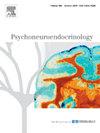Virtual reality based active shooter training: Added physical stress increases anxiety but not stress biomarkers
IF 3.6
2区 医学
Q2 ENDOCRINOLOGY & METABOLISM
引用次数: 0
Abstract
Tactical first responders such as firefighters and law enforcement officers are often exposed to concurrent or consecutive stressors. Exposure to concurrent stress challenges (i.e., combined mental and physical stress) has been shown to exacerbate stress biomarker responses. However, this has not been shown with short duration stressors (e.g., < 3 min). Therefore, this study compared markers of stress and perceived anxiety in response to a physical stressor [exercise alone; (EA)] to that of a dual stress challenge (DSC) which included a virtual reality based active shooter drill in addition to the exercise task. Fifty-four subjects (n = 54) completed either EA (n = 27) or DSC (n = 27). Measurements included salivary α−amylase (sAA), secretory immunoglobulin A (SIgA), heart rate (HR), and state anxiety inventory (SAI) which were collected four times: 1) 30 min prior to exercise 2) immediately prior to exercise 3) 5 min post exercise 4) 30 min post exercise. Both DSC and EA resulted in significant increases in salivary stress biomarkers (p < 0.05). The DSC resulted in significantly greater SAI values 5 min post exercise compared to the EA treatment. A secondary analysis demonstrated significantly lower sAA concentrations overall in females (n = 25) compared to males (n = 29), as well as significantly lower SIgA at five and 30 min post stress compared to males. These findings demonstrated that added mental stress causes significant increases in perceived anxiety compared to physical stress alone, and females demonstrate reduced stress biomarker responses to acute stress.
基于虚拟现实的主动射击训练:增加身体压力会增加焦虑,但不会增加压力生物标志物。
战术第一响应者,如消防员和执法人员经常暴露于并发或连续的压力源。暴露于同时的压力挑战(即精神和身体的双重压力)已被证明会加剧压力生物标志物反应。然而,短时间的应激源(例如,< 3 min)并未显示出这一点。因此,本研究比较了应激标记和感知焦虑对身体应激源的反应[单独运动;(EA)]到双重压力挑战(DSC),其中除了练习任务外,还包括基于虚拟现实的主动射击演习。54名受试者(n = 54)完成了EA (n = 27)或DSC (n = 27)。测量包括唾液α-淀粉酶(sAA)、分泌性免疫球蛋白A (SIgA)、心率(HR)和状态焦虑量表(SAI),采集四次:1)运动前30 分钟2)运动前立即3)5 运动后分钟4)30 运动后分钟。DSC和EA均导致唾液应激生物标志物显著增加(p
本文章由计算机程序翻译,如有差异,请以英文原文为准。
求助全文
约1分钟内获得全文
求助全文
来源期刊

Psychoneuroendocrinology
医学-精神病学
CiteScore
7.40
自引率
8.10%
发文量
268
审稿时长
66 days
期刊介绍:
Psychoneuroendocrinology publishes papers dealing with the interrelated disciplines of psychology, neurobiology, endocrinology, immunology, neurology, and psychiatry, with an emphasis on multidisciplinary studies aiming at integrating these disciplines in terms of either basic research or clinical implications. One of the main goals is to understand how a variety of psychobiological factors interact in the expression of the stress response as it relates to the development and/or maintenance of neuropsychiatric illnesses.
 求助内容:
求助内容: 应助结果提醒方式:
应助结果提醒方式:


